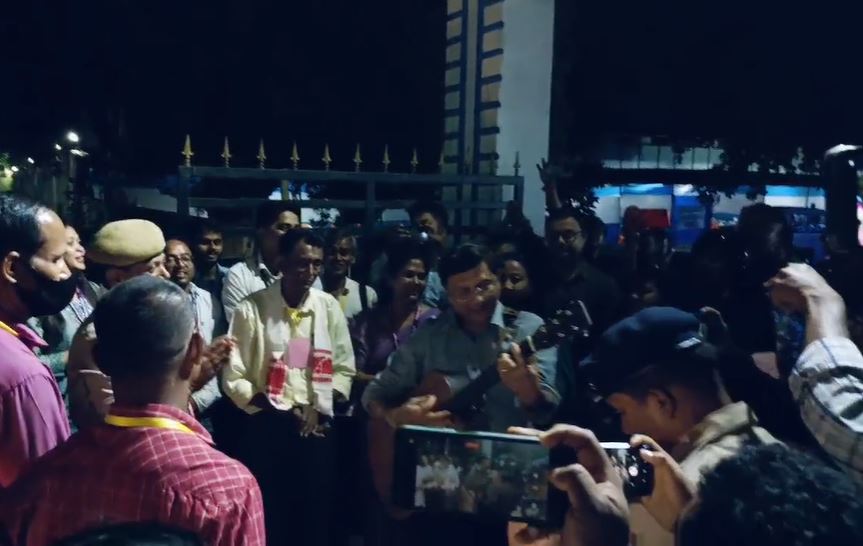A record number of voters cast a ballot in New Hampshire’s Republican primary on Tuesday, according to a New York Times analysis of election data, as former President Donald J. Trump cruised to an easy victory over Nikki Haley, his last remaining rival.
The total of more than 300,000 votes as of early Wednesday surpassed the previous high-water mark for a Republican primary, when more than 287,000 voters turned out in 2016. The previous record for either party was the Democrats’ 2020 contest, with more than 296,000 voters, many supporting Senator Bernie Sanders of neighboring Vermont.
The exceptionally high turnout on Tuesday underscores the electrifying effect Mr. Trump has on the electorate, driving loyal supporters and determined opposition to the polls as his divisive style of politics both inspires and revolts.
The A.P./VoteCast exit poll split the electorate, using Mr. Trump’s Make America Great Again movement as a dividing line. Mr. Trump won nearly 90 percent of the MAGA segment of the Republican Party, evidence of deep enthusiasm, while Ms. Haley carried about two-thirds of the non-MAGA base.
“It’s a double-edged sword,” said Michael McDonald, a professor at the University of Florida who specializes in American elections. “It cuts one way that Trump could draw out so many supporters. It cuts the other in that so many opposed him. When Trump is on the ballot he inflames passions.”
All three national elections held after Mr. Trump first took office produced exceptionally high turnout. The 2018 elections had the highest midterm turnout rate — 49 percent of the eligible voting population — since 1914. The 2020 presidential contest had the highest rate in any federal election since 1900.
And while the 2022 midterms had a slight decline with Mr. Trump not in office though still in the political conversation, they still had higher turnout than any midterm election since 1970.
“He’s picking right up where he left off in 2020, which saw the highest turnout in generations,” said Tom Bonier, a senior adviser to TargetSmart, a Democratic data clearinghouse. “New Hampshire was the first test of how that might have evolved, as an open primary and an opponent providing an outlet for anti-Trump voters to register their opposition. And it appears that, if anything, Trump is more polarizing than ever, mobilizing both supporters and opponents in potentially record-setting numbers.”
But a confluence of factors in New Hampshire, many particular to the state’s electorate and primary process, may have juiced the turnout.
Only one primary in New Hampshire was competitive this year. While President Biden did not appear on the ballot, he did not have a significant challenger besides Representative Dean Phillips, who will finish substantially behind a successful write-in campaign for the incumbent.
With just one competitive primary, the only choice for the more than 343,000 undeclared voters in the state to cast a meaningful ballot was in the Republican contest. (There are also marginally more registered Republicans than Democrats in the state.)
Throughout the day, precincts across the state reported signs of high turnout, though lines were rare.
A line of 70 people stretched outside the polling location in Meredith when polls opened at 7 a.m. The town clerk, Kerri Parker, said she anticipated “record turnout” in this village nestled along the shores of Lake Winnipesaukee. By 5 p.m., 2,254 of the ward’s 5,109 registered voters had cast a ballot.
Similar lines were a constant in Bedford, a wealthy suburb of Manchester. Nearly 5,700 people had voted in the town by midafternoon, with a further 959 absentee ballots reported and many voters still in line. Bedford has 15,613 registered voters in all. “This is definitely a high turnout,” said Bill Carter, a town councilor. “More than we see in town and state elections.”
As a midday snow began to coat the parking lot of the Peterborough Community Center, near the southern border of the state, Linda Guyette, the local clerk, said that almost 2,000 of the town’s 5,100 registered voters had already cast a ballot.
A similar pace was evident in Litchfield, about 20 minutes south of Manchester. The election moderator, Steve Perry, said that about 40 percent of the town’s 5,700 registered voters had cast their ballots by 4 p.m., and that the town typically experienced a post-dinner crush before polls close.
Not all towns were experiencing a surge. Rachel Deane, the Durham town clerk, said the vote count was much lower than the last primary as of 5 p.m. — around 2,800 ballots cast, compared with over 5,000 total in 2020. Ms. Deane attributed the drop-off in part to students at nearby University of New Hampshire having resumed classes. She said that President Biden’s absence from the ballot and Ron DeSantis’s recent departure from the race may have also affected turnout.
Soon after polls closed, David Scanlan, the Republican secretary of state of New Hampshire, who had predicted a record 322,000 voters in the Republican primary, said in an interview on CNN that turnout was high and some towns had requested more ballots throughout the day.
“I think my number’s in line, and it’s possible we’ll exceed it,” he said.
Reporting was contributed by Neil Vigdor, Kassie Bracken, Anjali Huynh and Nicholas Nehamas.
Follow us on Google news ,Twitter , and Join Whatsapp Group of thelocalreport.in
















